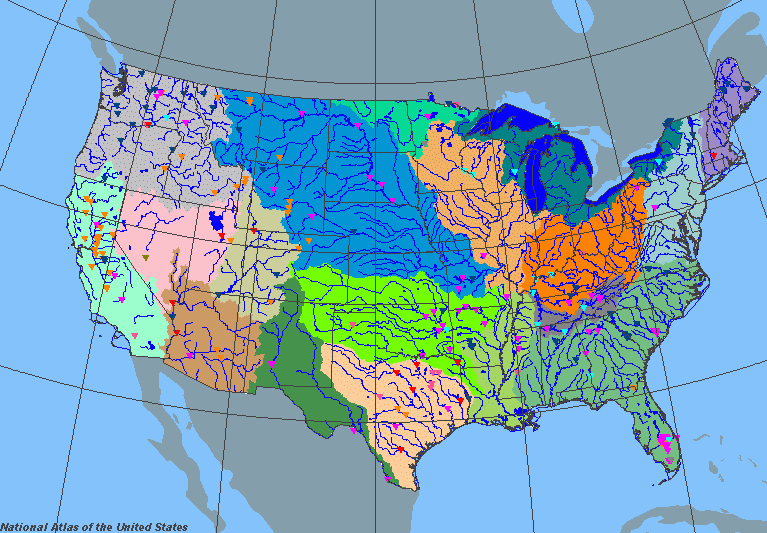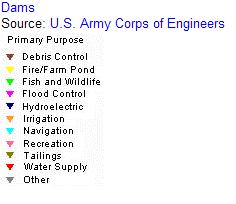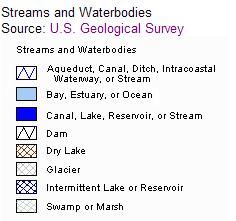
|
DamsIntroduction and BackgroundHydroelectric power, produced by the damming of rivers, is one of the most important alternative sources of energy utilized in the U.S. In 1995, it accounted for 95% of the total energy production in the country (U.S. Geological Survey [USGS], 2008). Currently, there are close to 75,000 dams in the U.S (Maclin & Sicchio, 1999, 8). The main benefits of using hydropower include the absence of fossil fuel burning or greenhouse gas emissions, and reliability, pending proper maintenance and repair (USGS, 2008). In the southwest, dams on the Colorado River, especially the Hoover Dam and Glen Canyon Dam, provide power to a vast population. The Hoover Dam generates enough power to provide for 1.3 million people in the states of Arizona, Nevada, and California (Engineering.com Inc., 2008). The Glen Canyon Dam supplies over 5 million people with power (Glen Canyon Dam Adaptive Management Program, 2007). These two dams also have the capacity to store 32,471,000 acre-feet and 27,000,000 acre-feet of water, respectively. In order to harvest hydropower however, dams must be built. Unfortunately, these structures obstruct the natural flow of a river. Structures that store the captured water, deemed reservoirs, are also in great need. Most of the water storage structures that hold the majority of the total water capacity in the U.S. were built from the 1940's - 1980's (USGS, 2008). Since then, dam construction slowed. This break in construction was because the most appropriate locations for dams were already exploited. Dam sites are deemed appropriate if the height and flow of the body of water are considerable, so as to harness significant potential energy. This energy is converted into mechanical energy through the movement of turbines, which in turn give way to an electric current that can be transmitted to consumers through power lines. Dam Demolition BackgroundThere has been ongoing debate regarding the concept of dam demolition, especially in the realm of the media. However, the fact that small dams have been demolished all over the United States, over 465 since 1912, seems to have been overlooked (Maclin & Sicchio, 1999, 9). When carried out correctly, removal of a dam can improve a river's ecosystem in a cost effective manner (Maclin & Sicchio, 1999, 9). Often times, dams that are obsolete or no longer functioning can be removed safely to improve the environment and to relieve taxpayers' economic burdens. This solution, however, should only be carried out in extreme circumstances, because it is possible to reduce the negative impacts of dams by simply improving their operation (Maclin & Sicchio, 1999, 13). There are three primary reasons for the removal of dams. The first of these is environmental. Damming a river can substantially damage the surrounding ecosystem by changing the physical, chemical, and biological state of the river. This occurs when the flow of the river is reduced or altered, which hinders the flow of nutrients, sediments, and wildlife migration. Dams can also alter the temperature and oxygen levels of the water, which leads to poor water quality. This low quality of the water puts the surrounding environment at risk. Hydropower dams and their negative environmental effects can decimate fish populations (Maclin & Sicchio, 1999, 9). Another reason for the demolition of dams is safety. With age and without proper maintenance and repairs, dams can become a significant threat to the surrounding communities. Certain dam failures even cost lives. For instance, four dam failures in the 1970s; the Buffalo Creek Dam in West Virginia, Canyon Lake Dam in South Dakota, Teton Dam in Idaho, and Kelly Barnes Dam in Georgia, resulted in the loss of 300 lives and hundreds of millions of dollars in damage (Maclin & Sicchio, 1999, 15). The average life expectancy of a dam is 50 years, and 25% of the dams in the Army Corps of Engineers National Inventory of Dams are now more than 50 years old. This number is projected to increase to 85% by the year 2020. The decision of whether or not to remove a dam is made based on the ability to remedy the deficiencies that could cause failure (Maclin & Sicchio, 1999, 16). Economic issues can also drive dam removal. As a dam ages, it can become less cost effective, especially as sediments build up and block the flow of water through the dam itself. In hydropower dams sediment can block the water from reaching the turbines which decreases efficiency even further. Additionally, older dams require more frequent maintenance and incur higher costs to repair and operate. Eventually, it may be determined that it is not cost effective to continue to maintain and repair an obsolete dam. In certain cases, the actual removal of the dam costs less than making repairs. Dam demolition also eliminates the need for recurring maintenance funding, which saves money also. In certain circumstances, it may benefit the community economically to remove a dam (Maclin & Sicchio, 1999, 16). Issues with DamsBy 2020, 85% of the dams in the U.S.will be half a century old and in need of repairing. A report by the ASCE deemed 3,300 dams within the U.S. unsafe. The Association of State Dam Safety Officials estimate that total repairs across the U.S. will amount to $36.2 billion (American Society of Civil Engineers [ASCE], 2007). Repairing only the structures with most urgent conditions will cost an estimated $10.1 billion over the next 12 years. The Dam Rehabilitation and Repair Act proposed in 2007 is pending approval. If enacted, it would provide $200 million over five years to repair public dams. However, in certain cases, if repairing the dam is not cost-effective, it can be demolished, which has the potential to disturb the surrounding ecosystem. This presents a dilemma; there is clearly not enough money to repair even the structures with the most urgent need and the negative environmental effects associated with the demolition of dams are great. Keeping in mind that there is only $200 million available over 5 years if the Dam Rehabilitation and Repair Act passes, it is necessary to not only prioritize the funding for dam reparation, but also to make drastic changes to the existence of the dams themselves. Additionally, it is imperative to ensure as little environmental damage as possible is done should any dams be destroyed.  

Read more in the Colorado River and energy sections. |

|